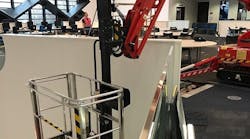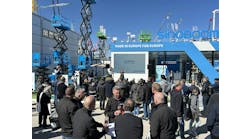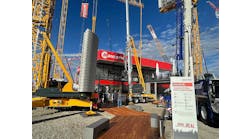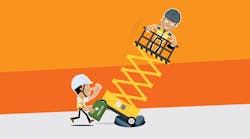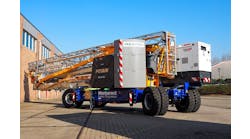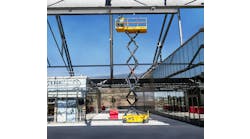RER interviews Ebbe Christiansen, president of Reachmaster about anti-entrapment systems, load sensing and the new ANSI standards, how seat belts saved millions of lives and more.
RER: What have been the major new developments to your company’s technology and products in the past year?
Christiansen: It’s been a busy year with several developments. From a safety point of view the biggest development has been the ability to deliver anti-entrapment systems on both our ReachMaster Falcon line as well as our Bluelift line. While these systems have been on the market for a while, we were the first to launch them on compact lift equipment. While it is a fairly small segment, we nevertheless found it important to offer this protection system as the compact lifts are used more and more in construction-related applications, which is where the largest risk is.
From a compact lift point of view, we launched both the Falcon FS108Z and the Bluelift B101 Combo with, respectively, 62 foot and 52 foot horizontal reach, which are a new benchmark for lifts in this category.
However, the biggest new development is no doubt our new Bluelift B35EB. This unit is specifically designed to operate in shopping malls, office buildings, hospitals and other buildings that typically do not have a big cargo elevator. The lift is very unique in two ways: For a start the unit features a so-called elevator system that will allow the unit to swing out over a handrail and then lower the basket below level, allowing the operator to work on both the handrails and items below thanks to the basket rotation. This feature is very sought after as a maintenance solution to any building that has glass railing where it is difficult to get to the outside area of the railing for cleaning and maintenance purposes.
The ace in the hole is the unit’s ability to transform into a 7 foot 8 inch-long unit thanks to a detachable jib system with a quick-lease coupler on hydraulics and electrics, so the jib and elevator part can be place on a small purpose-built dolly (included with the unit), so you can take the lift up in most standard people elevators, quickly re-assemble on the application floor and get the work done safely. Powered by a lithium battery system, it is noise and odor free, and obviously environmentally friendly. This unit will become a very important tool to increase safety in the above-mentioned work applications.
Finally, we have improved our remote access and diagnostic systems on, particularly, the ReachMaster Falcon units, allowing us to offer remote access to the data systems on the units, which again is a major efficiency factor in troubleshooting and repair situations.
Obviously the upcoming ANSI standards are an important topic. What have you done to change your equipment technologically to prepare it to be compliant with the new standards?
From an equipment point of view I have no doubt that the biggest change will be the load sensor systems.
While all manufacturers clearly state the maximum basket load capacity on their equipment, in particular construction applications have for decades considered that a “guiding” number, and overloading of more or less grave magnitude is taking place every day in North America. In response, most manufacturers have to a certain degree downgraded their equipment to allow for a buffer. With the new load sensor technology, the lift will shut down when overloaded, and the market will have to respect the manufacturers’ limits and instructions for proper use. That is without any discussion a very good thing, and something every stakeholder in the business should welcome.
From a practical point of view, however, there will be an interim period where the market will operate both equipment with and without this system, which can lead to confusion and potentially dangerous situations: If an operator is using a piece of equipment without the load sensor, but thinks it has the system, the operator could possible keep loading the basket until the sensor is activated, leading to actually overloading the unit. On the other side, an operator that is not aware the he/she is on a unit with load sensors may think there is a malfunction of the unit when it stops due to overloading.
Consequently, there will be a big task for the industry to educate the industry about these changes and how to practically go about them. So for example from an IPAF perspective, where I currently chair the North American Regional Council, IPAF has developed a decal that we will encourage rental companies and equipment owners to apply to all new units that is equipped with these new systems. Aside from confirming conformity to the new ANSI standards, it informs the operator that the unit will shut down in case of overloading. That brings awareness of the issue, and along with other initiatives will be needed until all units have these new systems.
For rental people, how will their responsibilities change with the new ANSI standards
There will be increased demands of proper instructions and training during delivery that shifts more responsibility on the dealer/rental companies, there are stricter demands on record keeping and overall there are several changes that elevates the responsibilities not only for the rental companies, but also the users, including the new requirement of mandatory risk assessment to name a few.
What do you suggest rental people do to communicate with their customers about the new ANSI standards?
I think it will depend on the rental company. The large national companies have in-house marketing and communication resources they can activate as far as running an educational campaign for their customers. I think that could range between everything from e-blasts with details about the new rules to POD casts, in-store display, creating specific web-pages where customers can get more information and overall the larger companies have a lot of tools available to get the message out. For the smaller, independent stores, the task is more comprehensive as they will typical have less in-house resources for this type of communication and will to a larger degree have to rely on external help. One source could be IPAF, which already have issued four different documents “ANSI Standard Dealer Guidance” that can be downloaded from their webpage, and I think other organizations like ARA, SAIA, TCIA to name a few are doing the same thing, trying to help their members to get the information out.
How will training programs change with the implementation of the new standards?
As mentioned above, the new standards will overall enhance the need and requirement for proper training, not just generally, but also depending on type of MEWP. It will change the way equipment is delivered and it will change the way GC’s for example is deploying equipment to job sites, and training becomes a very central part. While some may see these changes as an operational burden, the key point behind this very important revision of the standards is all about enhancing safety and create a safer work environment.
When Nils Bohlin, a Volvo engineer, invented the three-point seat belt for cars in 1959 and Volvo made it standard on their cars, the reaction was very mixed. Decades of habit to drive without seatbelts prompted a negative reaction to this safety feature as being “annoying and just something for race drivers and pilots”. Today, everyone – or at least most people – buckle up without even thinking about it because use of seatbelts has saved millions of lives over the past 60 years and has become a good safety habit. I think many of the elements in the new standards will follow the same trend. There might be some initial apprehension because the new standard mandates the industry stakeholders to change current procedures and most importantly how we think about safety, but in the long run I am convinced the new standard will bring a better and safer attitude to working on and with MEWPs.
What new safety measures have you implemented in the past year?
The most visual one is the anti-entrapment system now available, but overall thanks to the specialized nature of our product segment (compact lifts), we have for decades offered safety measures like auto setting, tilt alarms, motion detection on outrigger, anti-collision systems on basket.’ In short, we have tried to take as many operational decisions away from the user as possible and let the machine do the thinking! Aside from swinging the outriggers out manually and deploy the lock pin, virtually everything else today on our equipment is controlled through the CANBUS system with a large range of sensors and live-data collection & execution that will keep the operator safe. The great thing about that is the machine is not getting distracted by phone calls, or music streaming earplugs. Nor does it ever have a hang-over from a great night at the bar or having a cold and not 100 percent up to alert performance. Just like automation has made commercial flying safer than ever, having the equipment do the thinking (including the load and tilt sensor) will no doubt enhance safety.
Are you seeing an increase in demand for electric and hybrid machines and is your company or will your company participate in that market?
When we invented the compact lift industry in 1977 with the TS46, manufactured by then E. Falck Schmidt in Denmark, it was all based on electric power, and the standard for compact units became the 24v battery system that can be found on our Falcons in updated format to this date. In the early 1980´s there was a demand for additional power, so the units were offered with both battery power as well as a combustion engine or generator.
So, we have sold hybrids since the mid 1980’s as far as all our wheel-based units. As far as the track-based that became popular in the early 2000’s, given the smaller physical size of these units, the demand expanded into the lithium generations from 2010 forward. We pioneered the first dual lithium and combustion engine compact lift in 2010 with the Bluelift line, and today 90 percent of what we sell is so-called Combo models, which are hybrid between batteries for indoor use and combustion engines (gas or diesel) for outdoor use. That said, we actually see more and more demand on electric use outside as well, given concerns not only about the environment, but also the noise level at a job site.
So, we have without doubt been the pioneer on hybrid equipment in our small and narrow segment of the market, and I think we will see increased demand for electric units in applications that traditionally were solved with combustion equipment in the past. While electric power has many advantages, it also has its down sides. If any element of the power system goes down, the unit is stuck wherever it is. With the hybrids you always have the alternative power mode that can help you out of a location, allowing the unit to be transported off site. Consequently, I believe the hybrids represent a more operational reliable solution that electric power only.
Obviously, the rental industry is a major market for your equipment. Do you see any particular trends in the rental market that you’ve noticed? Have you seen new start-ups, new players coming into the rental market?
I read the same news as most people, where the national players get bigger and bigger, and where consolidation and merger seems to take up more news space than new start-ups. Should I comment on anything relating to our segment of the industry we’ve seen a very positive trend in the rental market in general. The interest in and understanding of what compact lift equipment can do to your business, your ROI and ability to provide customers with the right tool for the right job has clearly increased to a point where we don’t have to start with Adam and Eve whenever we present the compact lift concept.
While still a long way to go before the market here will mirror Europe, where the compact lift industry is much more accepted and long ago an integrated part of even smaller rental players, we see very positive development for our segment and increased awareness. One reason is no doubt the amount of providers now present in the market. When we pioneered the first compact lifts in the 1980’s there was basically two players in the market and it stayed that way for 20 years, making it an gigantic task to create product awareness. Today there’s about five or six times as many compact lift vendors being active in North America which has had a very positive impact on product awareness.
Anything you would like to add?
I am afraid I have already said more than most….. so the only concluding remark I have not only as a equipment provider, but also as the current chair of the IPAF North American council is to encourage all stakeholders in the industry to embrace the new ANSI standards and work towards implementing the various changes as quickly and positively as possible. Not only have the revision of the standards been long in the making, but it is also one of the most comprehensive overhaul of standards in decades where safety truly has been the unifying and central focus point. At the end of the day, that remains the number one priority of the industry.
